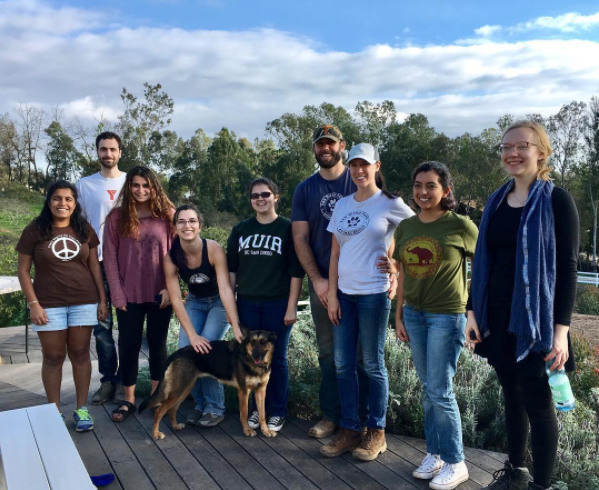John and Courtney Fiske are celebrating an anniversary next month. May marks a full year since they opened San Diego Farm Animal Rescue, in Escondido, California. Among their cherimoya trees, Courtney and John provide safe haven for elderly, abandoned and otherwise displaced horses, pigs, chickens, roosters and the like, from ranches and homes who simply can no longer care for them. To date, they’ve taken in 7 horses, 7 roosters, 6 pigs, and 27 hens. We caught up with our friends to chat about how they got into animal care-taking, what they’ve learned over the last year, and what’s on the horizon for San Diego Farm Animal Rescue.
Rachel Wohlander: Now that you’re just about a year into running SDFAR, what have been some unexpected joys & challenges?
John Fiske: We’ve really enjoyed sharing the farm animals with members of the community that would not otherwise have the opportunity to visit with animals in this way. From young students, and those with disabilities, to members of the public at large, our doors are open to anyone that wants to visit with these animals. Our biggest challenge so far has been, like all new projects, keeping enough money in the bank account.
RW: The reasons for being dedicated to the welfare of all creatures may be obvious. But what are your personal reasons for investing yourselves so deeply in the care of your rescue animals?
Courtney Fiske: We were inspired to begin SDFAR by the movie
Cowspiracy, which exposes the environmental consequences of large scale commercial animal agriculture. SDFAR has given us an opportunity to educate the public on these impacts.
RW: How have your different backgrounds led up to this endeavor? Are there any skills/mindsets from other aspects of your life that aid in farm life?
JF: I started horse back riding about six years ago, and I fell in love with the challenge and rewards of working closely with horses. Then I educated myself about the actions of the Bureau of Land Management and its wild horse management practices favoring cattle grazers by removing wild horses from their habitat into enclosed stalls. I also became educated about the horse slaughter industry and when I learned that 2500 horses per week are shipped to Canada and Mexico for slaughter, I decided I wanted to rescue horses. In addition, as an environmental lawyer focusing on water contamination, I wanted to continue my interest in conservation and create a haven to educate the public.
CF: I learned to take care of horses when I was 11 years old. I started barrel racing when I turned 14 and truly started to experience the bond formed between horse and rider. I grew up an animal lover and always wanted to become a veterinarian.
RW: Your farm has not only been a haven for animals, but for people as well, from your friends & neighbors to volunteers & students. What are the ways you think SDFAR is forming a community around it, and how does it do this?
JF: The rescue offers hands on interactive experiences that are not based in any doctrine or ideology, and allow visitors to freely explore and experience farm animals in a way that allows them to make their own connection and draw their own conclusions. San Diego Farm Animal Rescue is an inclusive, hands on experience.
RW: Do you have a favorite animal on the property? Do any of your critters have particularly pronounced personalities that make things interesting and fun?
CF: Our favorite animal is a horse. We have the most experience caring for horses, but learning about the nature of our other rescue farm animals has been entertaining, challenging, and exciting. That said, each of our animals have their own unique personalities and story to be told.
RW: Running this place seems like a lot of work! How do you do it? How do you schedule your time and prioritize chores?
JF: It’s a lot of hard work. You just need to put your own emotions and stress aside in order to do all of the hard work. Just get started.
RW: Taking care of retired farm animals with potential health problems sounds expensive! SDFAR is a nonprofit that is funded by the sale of cherimoyas from your orchard, visitors paying to stay at the guesthouse, donations and your own personal investment, correct?
CF: That’s right. In addition to everything you mentioned, after our first year, we are starting to focus more on our donors. We’ve recently introduced the opportunity to
Sponsor a Rescue Animal on our website. Sponsoring an animal helps us to pay for feed, proper care, and unexpected expenses for all the animals we take in. We’re grateful to each of our donors who are currently sponsoring one of our farm animals.
RW: Do you have any advice for someone interested in pursuing a similar project?
JF: Just get started! When we started SDFAR, we had no money, no volunteers, and one old horse. We had to build the farm from the ground up. Those looking to make a difference should trust the community around them to respond, as our community responded to our vision. The number one most important aspect to any successful rescue is the continued flow of resources, including monetary donations. 100% of our proceeds to SDFAR go directly to the animals without administrative overhead. As we grow, that may change as the rescue grows in complexity. For now, we continue to be grateful for our donors big and small, and we look forward to increasing our ability to help more animals in the future.
CF: We started out small and learned as we went. We would be happy to discuss specifics if anyone is interested in learning more!
John and Courtney are celebrating their anniversary by hosting their
2nd Annual SDFAR Hoedown on May 6th at 2pm! The event will feature food, drinks and live music, so if you’re in the area, stop on by!
